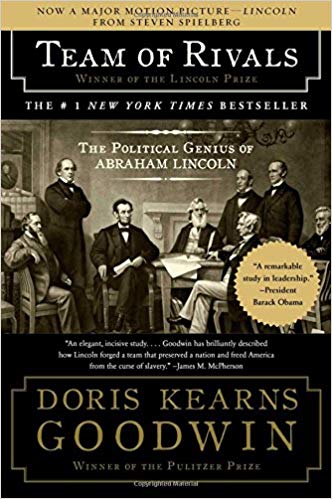Team of Rivals Summary

3 min read ⌚
The Political Genius of Abraham Lincoln
“Team of Rivals” offers a look at the history of Abraham Lincoln’s legendary governance.
About Doris Kearns Goodwin

Doris Kearns Goodwin is a Pulitzer-winning author.
“Team of Rivals Summary”
In May 1860, while the US was battling the issue of slavery in the South, while abolitionists were taken control in the North, the new Republican Party of the US gathered together in Chicago to nominate its first candidate for president.
They chose among four candidates: the front-runner William H. Seward, Salmon P. Chase, Edward Bates, and Abraham Lincoln.
During the Republican nomination, however, Lincoln, although was thought unlikely, outmaneuvered all three other men.
He made a campaign that relied on good networking, organization, and a superior ground game, while his opponents missed opportunities and made mistakes.
When the frontrunner Seward did not secure a victory in the first ballot, Lincoln was the next choice.
To everyone’s surprise, except his own, Lincoln secured his nomination on the third ballot.
In November, he won the general election as well.
In 1861 he was preparing to assume office, and he knew that he needed to gather the most reliable possible cabinet.
So, he appointed Seward to be the secretary of state, named Bets as attorney general, Montgomery Blair as postmaster general, and Case as secretary of Treasury.
Chase believed he had superior qualities to those of Lincoln and had ambitions to enter the White House as the president himself, which Lincoln privately recognized but never made a problem of them.
In the first year, the civil war that followed because of Lincoln’s election went bad for his Northern troops.
The cabinet had to go through many war issues, among which the plan to free the slaves.
Lincoln wanted to relieve the country of all half-measures that did not solve the problem and finally put an end to it. He believed that all freed slaves would want to fight for the Union, so he also was eager to take advantage of that workforce.
Key Lessons from “Team of Rivals”
1. Working Behind the Scenes
2. Forgiveness
3. The “Team of Rivals”
Working Behind the Scenes
At the beginning of 1864, as the tide of the war begun to turn in favor of the Union, Chase was planning to run for a president.
Lincoln knew him well, and kept him in the office, first because he was an excellent worker, and second because he wanted to keep him too busy to do a major election push.
Forgiveness
Chase continued to stage his election.
However, a confidential memo criticizing Lincoln and endorsing his candidacy came to light and turned everyone in the party against him.
Chase withdrew his bid and wrote the president a conciliatory letter.
After letting him sweat for a while, Lincoln absolved him of the blame.
The “Team of Rivals”
Lincoln’s political savviness became evident a long time after his governance. He always waited for the right moment to make a decision and remained unswayed by his advisors, popular opinion, and even his own doubts.
His skills were most visible in handling his cabinet consisted of a “team of rivals.”
Like this summary? We’d Like to invite you to download our free 12 min app, for more amazing summaries and audiobooks.
“Team of Rivals” Quotes
Washington was a typical American. Napoleon was a typical Frenchman, but Lincoln was a humanitarian as broad as the world. He was bigger than his country - bigger than all the Presidents together. Share on X An adult friend of Lincoln's: Life was to him a school. Share on X A real democracy would be a meritocracy where those born in the lower ranks could rise as far as their natural talents and discipline might take them. Share on X And Lincoln, as would be evidenced throughout his presidency, was a master of timing. Share on X Always bear in mind that your own resolution to succeed, is more important than any other one thing. Share on X








